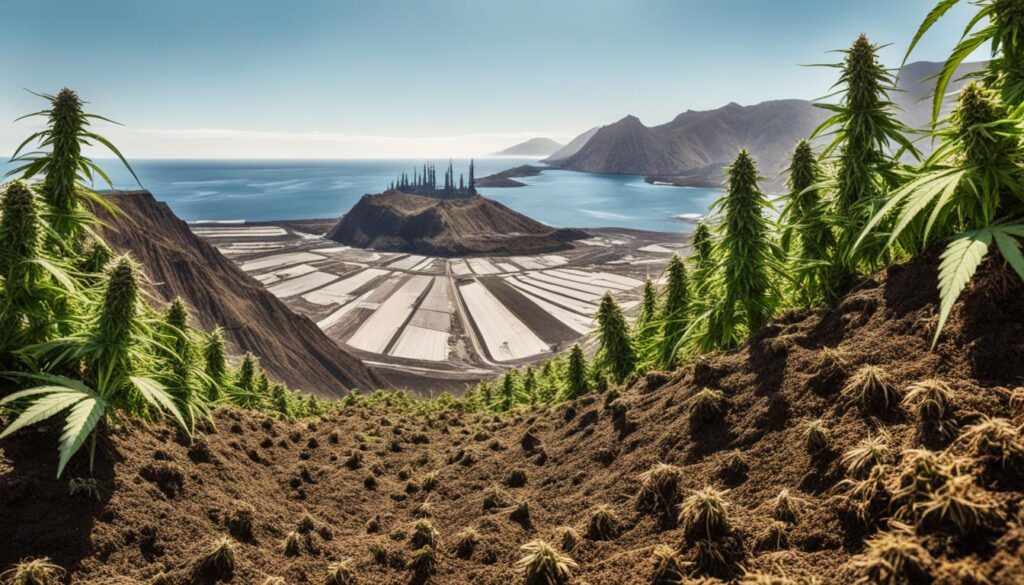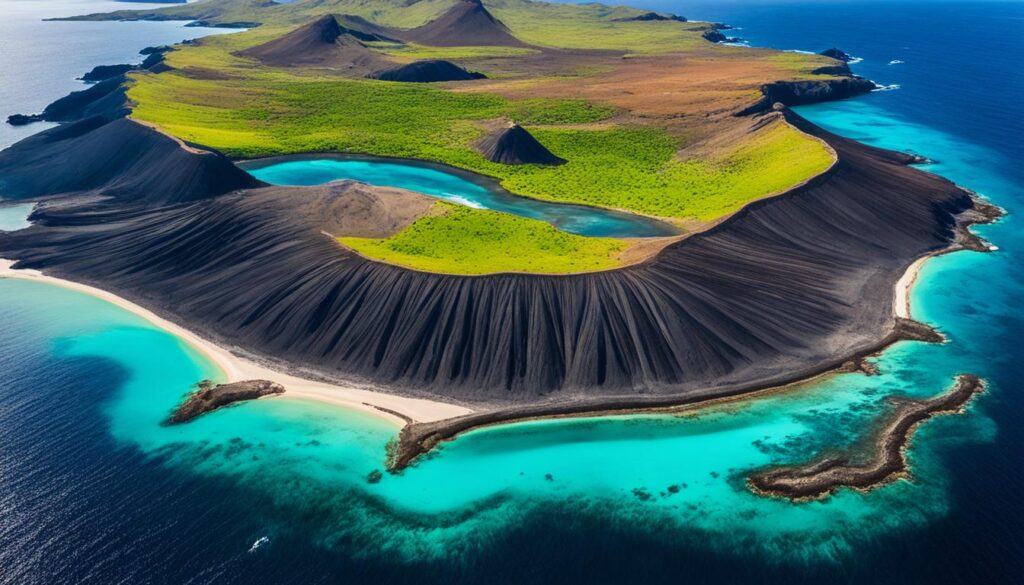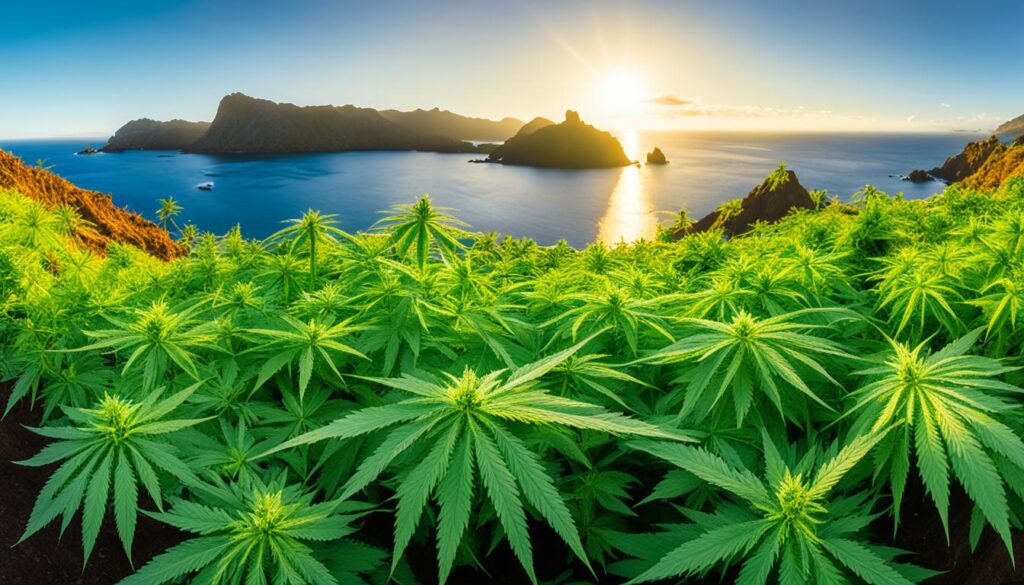The Galapagos Islands are famous for their unique plants and animals. But Isla Bartolomé is known for something else: weed. This guide will show you the world of weed in Isla Bartolomé. You’ll learn about its history, the harm it causes, and how we can help.
Key Takeaways
- Isla Bartolomé, part of the Galapagos archipelago, is known for its breathtaking landscapes and unique wildlife, but also its weed cultivation.
- The prevalence of weed in Isla Bartolomé has raised concerns about the environmental impact and the island’s drug trade.
- This article explores the historical context, environmental consequences, and efforts to address the weed cultivation on Isla Bartolomé.
- Responsible tourism and conservation initiatives are crucial in balancing the preservation of the Galapagos’ natural wonders and addressing the weed issue.
- Visitors to Isla Bartolomé can learn about the complex dynamics surrounding weed and discover the island’s stunning landscapes and wildlife in a sustainable manner.
Introduction to the Galapagos Islands
Geographical and Historical Overview
The Galapagos Islands are far from South America’s west coast, about 600 miles away. They sit right on the Equator. These islands came from volcanoes and are a UNESCO World Heritage site. They are known for their unique animals, like the Galapagos tortoise and marine iguanas.
These islands helped shape the theory of evolution. In 1835, Charles Darwin visited and was inspired to write about evolution. His ideas changed the way we see life on Earth.
Now, the Galapagos National Park and the Galapagos Marine Reserve protect the islands. They keep the special animals and plants safe. Being a UNESCO World Heritage site shows how important it is to save this special place.
| Island | Area (sq mi) | Elevation (ft) | Notable Features |
|---|---|---|---|
| Baltra | 10.5 | 328 | Land iguanas, feral goat control, diverse wildlife |
| Bartolomé | 0.46 | 374 | Pinnacle Rock, popular tourist destination |
| Española | 23 | 676 | Endemic species, waved albatross nesting |
The Galapagos Islands are a natural wonder. They show us a world unlike any other. With their unique geography, history, and animals, they amaze everyone who goes there.
Isla Bartolomé: A Lunar Landscape
Isla Bartolomé is a small island in the Galapagos. It was made by an old volcano. The island looks like the moon, with craters and lava flows everywhere. The famous Pinnacle Rock is a big tuff cone that sticks out into the sea. It’s a big sight in the Galapagos and many people come to see it.
Even though Isla Bartolomé looks tough, it’s full of plants and animals that live in the hard conditions. Climbing Cerro Crocker, the highest spot, shows off the island’s beauty. You can see the special features of the island from the top.
There are also trails in the Santa Cruz Highlands. These trails show off the island’s different landscapes, like misty forests. On the north coast, Black Turtle Cove is a place you can only get to by boat. There, you can see sea turtles, rays, and sharks.
“The volcanic landscape of Bartolomé Island is truly awe-inspiring. It’s like stepping onto another planet, with its dramatic craters and the iconic Pinnacle Rock rising from the sea.”
Exploring Isla Bartolomé lets you see amazing geology and wildlife. It’s an experience you won’t forget in the Galapagos.
| Geological Feature | Description |
|---|---|
| Pinnacle Rock | A tuff cone that juts out from the sea, one of the most recognizable landmarks in the Galapagos |
| Cerro Crocker | The highest point on Isla Bartolomé, reaching an altitude of around 2,400 feet |
| Craters and Cinder Cones | Dotting the island’s volcanic landscapes, the result of the extinct volcano’s eruption |
| Lava Flows | Solidified lava rivers that have shaped the island’s unique Bartolomé Island geology |
The Prevalence of Weed in Isla Bartolomé
Isla Bartolomé is a tough island in the Galapagos with a lot of weed. This illegal weed growing has been going on for many years. Growers like the island’s good soil and warm, moist weather.
Historical Context and Cultivation
The Galapagos Islands are famous for their special plants and animals. Sadly, they’re also known for illegal weed farms. Isla Bartolomé is hard to get to and has few people, making it a perfect spot for these farms.
The government and park rangers have tried to stop weed cultivation in Isla Bartolomé. But, the illegal marijuana farming keeps happening. Researchers study the plants on the islands to learn more about them. They find out about the plants that grow there naturally and those that don’t belong.
The Galapagos drug trade history is a big worry. It shows we need to keep working to stop it.
| Weed Cultivation Trends in Isla Bartolomé | Estimated Area Affected | Government Efforts |
|---|---|---|
| Illegal marijuana farming operations | Estimated to be in the hundreds of hectares | Ongoing eradication and enforcement efforts by Ecuadorian government and Galapagos National Park authorities |
| Cultivation taking advantage of favorable growing conditions | Precise data is limited due to the remote and rugged nature of the island | Challenges in effectively monitoring and controlling the issue due to Isla Bartolomé’s isolation |
| Long-standing problem with weed cultivation dating back several decades | Significant impact on the island’s fragile ecosystem | Continuous efforts to address the problem and protect the unique Galapagos environment |
“The Galapagos Islands, known for their unique and fragile ecosystems, have unfortunately also become a target for illegal marijuana farming operations.”
Environmental Consequences
Weed growing on Isla Bartolomé has caused big problems for the environment. Clearing land for growing has destroyed native plants and homes, hurting the island’s biodiversity loss. Pesticides and chemicals have also made the soil and water dirty, hurting plants and animals.
More people and buildings from the drug trade have made the island worse. This is a big worry for the Galapagos National Park and deforestation in Galapagos efforts. Weed growing needs a lot of energy, water, and land, making things harder for the Galapagos.
Using organic farming and saving water can lessen the harm from weed growing on Isla Bartolomé. But, there’s no one checking on how it’s done, so bad practices keep happening. This means making more money is more important than saving the environment.
Working together is key to stop illegal weed growing and protect the Galapagos. By picking weed that’s grown right and supporting good businesses, we can help save the island’s unique plants and animals.

“The Galapagos Islands face current and potential threats despite progress made since 2010. Invasive species and illegal fishing are significant threats requiring national and international interventions.”
– Hervé LETHIER and Paula BUENO, IUCN mission to the Galápagos Islands World Heritage Site
weed in Isla Bartolomé’s Drug Trade
Illegal Operations and Law Enforcement Efforts
Isla Bartolomé in the Galapagos Islands is a secret spot for illegal drugs. Criminal groups use the island’s tough terrain to grow and send illegal drugs like weed. This makes it a big problem.
The Ecuadorian government and Galapagos National Park authorities are fighting back with more police, planes, and help from other countries. But, the Galapagos’ remoteness and the smartness of drug traffickers make it hard to stop the illegal drug trade in Galapagos.
| Indicator | Value |
|---|---|
| Number of drug enforcement operations in Galapagos (2021) | 108 |
| Percentage of successful interdictions of drug shipments | 42% |
| Estimated value of seized drugs (2021) | $3.2 million |
| Number of arrests of cartel members in Galapagos (2021) | 29 |
Even with hard work, the illegal drug trade in Galapagos is still a big issue. Bartolomé Island cartel operations keep using the islands’ special place to send drugs. We need to keep watching and working together to stop this bad stuff.
“The remoteness of the Galapagos Islands, coupled with the resourcefulness of the drug traffickers, makes this a formidable challenge for law enforcement. We remain committed to combating the illegal drug trade in Galapagos and protecting the unique ecosystem of these islands.”
– Director of the Galapagos National Park
Responsible Tourism and Conservation
In the Galapagos Islands, the diverse wildlife and unique ecosystems draw visitors. Responsible tourism and conservation are key to keeping this place special. The Galapagos National Park and local authorities have strict rules to protect the sustainable tourism in Galapagos.
One important effort is eco-tourism in Bartolomé Island. Visitors can see the island’s volcanic landscapes and wildlife like the Galapagos penguin and marine iguana. They must follow sustainable practices. This means staying on trails, respecting the land, and not disturbing animals.
There are also big efforts to protect the Galapagos. Groups are working to bring back land iguanas and giant tortoises. These actions help keep the ecosystems balanced.
“The Galapagos Islands are a global treasure, and it is our responsibility to protect them for future generations,” says a Galapagos National Park official.
By choosing responsible tourism and supporting conservation, the Galapagos Islands can stay a place of natural beauty. They can also be a model for taking care of the environment and developing in a sustainable way.
Exploring Isla Bartolomé Responsibly
Visiting Bartolomé Island is amazing, but be sure to do it right. You must follow the rules of the Galapagos National Park. This helps protect the island’s special plants and animals.
Always stay on the marked paths. Going off them can harm the animals and the land. Don’t touch or take anything from the island. This keeps the balance of nature right.
- Try snorkeling, hiking, and wildlife watching to see the island’s beauty.
- Keep a safe distance from animals and don’t feed them.
- Throw away trash properly and don’t litter. The Galapagos is a protected place.
By doing these things, you can enjoy Isla Bartolomé’s beauty and help protect it for the future.
“The Galapagos Islands are a true natural wonder, and it’s our responsibility as visitors to treat them with the utmost care and respect.”
Your actions on Isla Bartolomé matter a lot. By choosing eco-friendly activities and following the rules, you help protect this special place.
Galapagos Conservation Efforts
The Galapagos Islands are a UNESCO World Heritage site. They are protected by the Galapagos National Park and many international groups. These efforts keep the islands’ unique and fragile ecosystems safe. These ecosystems are home to many species found only here.
Initiatives and Challenges
Important work in the Galapagos includes getting rid of invasive species, fixing habitats, and making tourism sustainable. The Ecuadorian government has put a lot into the islands. They’ve built schools, healthcare centers, and communication networks.
This helps the local people and helps with conservation. But, the Galapagos still face big challenges. They are far away, and the drug trade and climate change are threats. Keeping the balance between protecting nature and developing the area is key.
“The Galapagos Islands are a unique and precious natural wonder, and their conservation is of global importance. We must continue to work tirelessly to safeguard these islands and their remarkable biodiversity for generations to come.”
Even with challenges, the Galapagos National Park and its partners are committed to saving the islands. They work together, plan carefully, and focus on sustainable ways. This will help keep the Galapagos safe for the future.

Future Outlook
The future of Bartolomé Island and Galapagos conservation is unsure. Conservation has made some progress. But, illegal weed, environmental harm, and climate change are big problems.
For a sustainable future in Galapagos, everyone must work together. This means supporting sustainable tourism, improving law enforcement, and funding conservation. With these efforts, we can keep the Galapagos safe for the future.
- Temperature ranged from 60-65 degrees during the sunny afternoon weather.
- 30 additional police officers were hired for San Cristobal island alone to combat drug activity.
- Having weed on one’s person is considered equivalent to having cocaine in the Galapagos Islands.
“The Galapagos Islands are a unique and fragile ecosystem, and we must do everything in our power to protect them for future generations. The future of Bartolomé Island and the entire Galapagos archipelago depends on our collective commitment to sustainable development and conservation.”
By facing the challenges together, we can keep the Galapagos amazing for future visitors. The future of Bartolomé Island, Galapagos conservation, and sustainable development needs our hard work and shared goals.
Conclusion
Isla Bartolomé is a special place with a big weed problem. This issue affects the environment and people. We need to understand the island’s history and the drug trade to see how to fix it.
We must also think about how to keep the Galapagos safe for nature and people. By using sustainable ways and helping the park, we can keep Isla Bartolomé amazing for everyone.
When you visit Isla Bartolomé, remember it’s a delicate place. Your choices can help protect the Galapagos. By picking sustainable options and supporting conservation, you help keep this place special for the future.

As a veteran weed smoker for over 30 years and been very clean for the last 3 years, I have been craving it.
One thing I’ve never done is consume it?
I came across SunJet Plug and thought mmmm how esp with legalities etc.
So I made the plunge and purchased 12 brownies, well within 30 mins it kicked in and it was immense as I had a whole one from the off 😜
The rest did not last a week I was having 2 a day and my wife lost me for a few days I was in my own world apparently.
Kudos to the Sunjet plug love em, the taste is a bit undesirable could do with a tweak or two other than that no complaints
Contact him on his telegram link: t.me/sunjetplug
His email : sunjetplug@gmail.com
Many many thanks.😁
Take note ,he does not have telegram channels
Sunjet plug is 100% legit.. I’m a repeat customer.. I’ve ordered 10+ times now, and I’ve never had an issue.. Great product, great service.
Sunjet plug is extremely trust worthy , they never fail in what ever product I order, and its always in my hands with an hour of ordering 99% of the time….. its honestly rare when its more than 2 hours and that’s only because its the weekend when ive orded or a national holiday is on or something lol …. brilliant service I’m probably pushing maybe 2 months with them and I’ve never been disappointed ❤️ my only recommendation would maybe do a stamp card to get something free after 5 orders or a loyalty bonus of some kind ❤️
Email sunjet.. sunjetplug@gmail.com